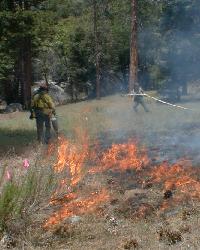- Home
- About S&T
- Taxa/Organisms
- Ecosystems
- Issues
- Methods & Tools
- Reports & Publications
- Location
- Search
Publisher: USGS | Science Center: Columbia Environmental Research Center (CERC, Columbia) | Format: URL
www.cerc.usgs.gov — This issue overview discusses the notion that photo-enhanced toxicity is likely a function of UV radiation intensity and duration of exposure, and thus is dependent on the amount of suspended solids, plankton, and organic matter which absorb UV wave lengths in the water column. During this three year investigation Columbia Environmental Research More...

Publisher: USGS | Science Center: Forest and Rangeland Ecosystem Science Center (FRESC, Corvallis) | Format: URL
fresc.usgs.gov — Spotted owls are mostly non-migratory, long-lived birds whose populations have declined in mature forests of western North America. They are classified as three subspecies: California, northern, and Mexican. Northern and Mexican spotted owls are listed as threatened under the U.S. Endangered Species Act, and California spotted owls are not. In More...

Publisher: USGS | Science Center: Forest and Rangeland Ecosystem Science Center (FRESC, Corvallis) | Format: URL
fresc.usgs.gov — Dense vegetation, rough terrain, and other variables may make it difficult to monitor forest-dwelling mammals. When direct counting is not practical, researchers in forested regions often rely on surveys of scat (animal waste) to study the abundance and distribution of the large animals. Biases, such as using different observers, may limit the More...

Publisher: USGS | Science Center: Western Ecological Research Center (WERC, Sacramento) | Format: URL
www.werc.usgs.gov — Riparian vegetation is intimately linked to the stream and river channels along which it grows. This project addresses the status of the riparian zone along Redwood Creek north coastal California, and answers three questions: 1) How have the overstory riparian conditions changed in Redwood Creek and major tributaries since the advent of timber More...

Publisher: USGS | Science Center: Western Ecological Research Center (WERC, Sacramento) | Format: URL
www.werc.usgs.gov — This resource provides an overview of the research on ways to prevent invasive annual grass invasions and restore invaded habitats, which has independently and repeatedly been identified by all land management agencies as a top national research priority. Annual grasses have invaded a number of shrub and forest ecosystems in western North America More...

Publisher: USGS | Science Center: Western Ecological Research Center (WERC, Sacramento) | Format: URL
www.werc.usgs.gov — USGS scientists are conducting research through the Joint Fire Science Program to determine if fire contributes most to plant invasion in low-nutrient soils by making available increased nutrients that invasive grasses may exploit more effectively than native flora. Soil nutrient changes can vary widely depending on soil properties and the amount More...

Publisher: USGS | Science Center: Fort Collins Science Center (FORT, Ft. Collins) | Format: URL
www.fort.usgs.gov — The severity of wildfires in recent years has increased public awareness and concern about a fuel build-up in western U.S. forests. Federal land management agencies are responding by greatly expanding programs to reduce hazardous fuels, but little is know about the efficacy of fuel treatments for mitigating wildfire severity or the influence of More...

Publisher: USGS (San Diego Field Station) | Science Center: Western Ecological Research Center (WERC, Sacramento) | Format: URL
www.werc.usgs.gov — The Pacific iguanas of the Fijian and Tongan archipelagos are a biogeographic enigma in that their closest relatives are found only in the New World, separated by 8,000 km of ocean. The Pacific iguanas have been dramatically affected by human activities; two species were eaten to extinction after human arrival in the Pacific some 2,800 years ago. More...

Publisher: USGS | Science Center: Fort Collins Science Center (FORT, Ft. Collins) | Format: URL
www.fort.usgs.gov — This resource has been developed to provide source materials on the history of the invasion, continuing threats, research results, and containment and management of the brown Treesnake (Boiga irregularis) in Guam and its relevance to other islands and mild continental environments. Users can report snake sightings on this website, get information More...

Publisher: NBII | Format: URL
www.nbii.gov — Natural resource managers face complex decisions that require a clear understanding of the status of wildlife populations and their habitats. Monitoring is key to making effective management decisions and evaluating the outcomes of those decisions. The goal of NRMP is to improve the accessibility of monitoring efforts to resource managers to aid More...

Publisher: USGS | Science Center: Fort Collins Science Center (FORT, Ft. Collins) | Format: URL
www.fort.usgs.gov — Natural Resource Monitoring Partnership (NRMP) is a collaborative effort by the natural resource management community to improve monitoring efforts in order to support effective evaluation and decision-making by sharing information on monitoring projects and protocols. The Natural Resource Monitoring Partnership was built for easy access to More...

Publisher: USGS | Science Center: Western Ecological Research Center (WERC, Sacramento) | Format: URL
www.werc.usgs.gov — Where nonnative plant species have invaded wildlands or have potential to invade, fire may influence their abundance and the effects of the nonnative species on native plant communities. USGS scientists and colleagues have contributed chapters to a volume that synthesizes scientific information regarding wildland fire and nonnative invasive plant More...
